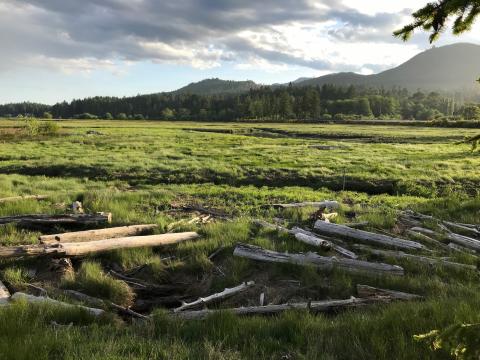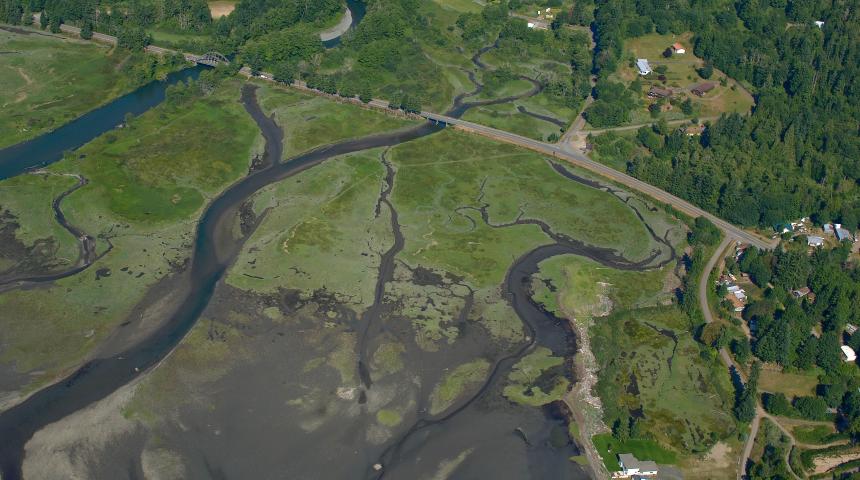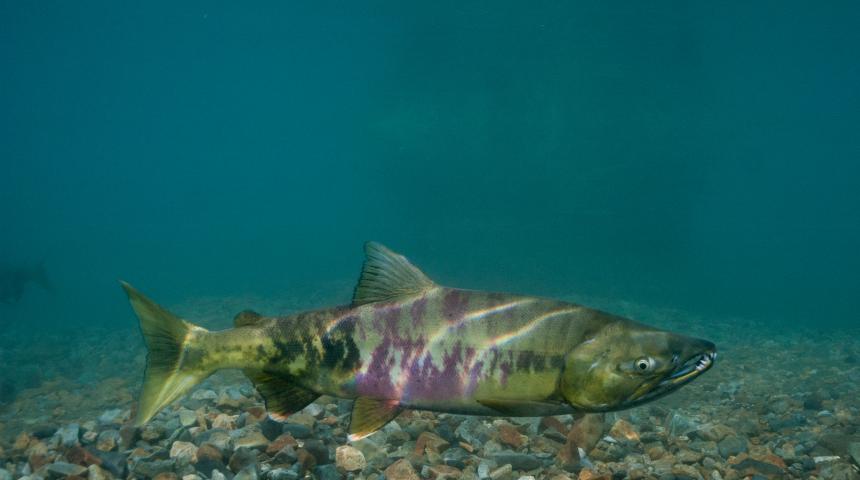- May 27, 2025: Duckabush Estuary Education Tours: Last Wednesday of the month, May through September.
Read all project updates below.
The Duckabush estuary has been degraded for almost 100 years by a wall of highway fill that nearly severs the ecological connection of the estuary to the tidelands.
The Washington Department of Fish and Wildlife (WDFW), in partnership with the U.S. Army Corps of Engineers (Corps) and the Hood Canal Salmon Enhancement Group (HCSEG), is proposing an estuary restoration project to correct this legacy environmental impact. The estuary is important habitat for salmon and other fish and wildlife, including several species listed under the federal Endangered Species Act. The restoration project would reconnect the Duckabush River to neighboring floodplains and wetlands by modifying local roads, elevating Highway 101 onto an estuary spanning bridge, and reconnecting historical channels.
Restoration activities are primarily on public land at the Duckabush Wildlife Area Unit managed by WDFW. Project design is expected to be complete in 2025. Once construction funding is secured, construction would take about five years.
Project benefits
- Improve habitat for fish and wildlife, including Hood Canal summer chum and Chinook salmon, a main food source for endangered Southern Resident Killer Whales.
- Reduce seasonal flooding in the area, benefitting both public and private property.
- Provide a modernized highway design that meets current safety standards.
- Create approximately 1,300 jobs and support the local economy.
- Establish a wildlife corridor under the highway to improve habitat connectivity and reduce wildlife-vehicle collisions.
Project details
Location

Duckabush Wildlife Area Unit
The Duckabush Unit is located 4 miles south of Brinnon, and 22 miles north of Hoodsport, in Jefferson County. The unit can be accssed from Highway 101.
Partners involved
- Hood Canal Salmon Enhancement Group (HCSEG)
- Washington Department of Fish and Wildlife (WDFW)
- Washington Department of Transportation (WSDOT)
- U.S. Army Corp of Engineers (USACE)
Project design
A preliminary project design was developed by WDFW, WSDOT, and the U.S. Army Corps of Engineers in coordination with local Tribes, County government, and local conservation organizations. The current design partnership is incorporating site-specific data and public input to refine the preliminary design.
Preliminary project features include:
- Restoration and reconnection of several historic tidal and river channels to improve fish and wildlife habitat.
- A new 1,600-foot-long estuary-spanning bridge designed to accommodate future high tide and flood conditions.
- Wider highway shoulders, a re-designed intersection at Duckabush Road, and a left turn lane from northbound Highway 101 onto Duckabush Road.
- Additional public parking next to Duckabush Road at the north end of the new bridge to provide access to the Wildlife Area.
View the preliminary project design. (PDF)
A virtual public meeting showcasing the preliminary design was held on Sept. 22, 2021. People can review the meeting's presentation (PDF) for more details.
Environmental review
Consistent with the State Environmental Policy Act (SEPA) RCW 43.21C, the WDFW determined that this project may have a significant adverse impact on the environment for which an Environmental Impact Statement (EIS) must be prepared.
WDFW adopted the Puget Sound Nearshore Ecosystem Restoration: Final Integrated Feasibility Report and Environmental Impact Statement (IFR/EIS) following WAC 197-11-630 adoption procedures. The final IFR/EIS was issued by the US Army Corps of Engineers in compliance with National Environmental Policy Act (NEPA) requirements and includes an analysis of the Duckabush Estuary Restoration site.
Further details can be found on the Duckabush Environmental Review webpage.
Community engagement
Events
Public meetings and open houses that WDFW and project partners have hosted over the last several years.
Public Open House
- May 4, 2024 from 10 a.m. - 12 p.m. | Brinnon Community Center, 306144 Highway 101
Preliminary Design Online Public Meeting
- Sept. 22, 2021 from 6 - 7 p.m. | Online via Zoom webinar
- Meeting materials: presentation (PDF)
Public Open House
- Feb. 8, 2020 from 10 a.m. - 12 p.m. | Brinnon School, 46 Schoolhouse Road
SEPA Scoping Meeting
(Refer to the Duckabush Environmental Review page for more information.)
- July 13, 2019 from 9:30 - 11:30 a.m. | Brinnon School, 46 Schoolhouse Road
- Meeting materials: SEPA scoping public meeting presentation (PDF) and posters (PDF)
Media
In the news
- Open house set for estuary project
- On the Olympic Peninsula, reworking a highway to restore a river (Washington State Standard)
- A Chance To Go With The Flow: Plans include removal, replacement of US 101 bridges and highway through critical habitat (Port Townsend Leader)
- Duckabush restoration promises major benefits for five species of salmon (Kitsap Sun)
- Estuary restoration moving forward on Hood Canal (Peninsula Daily News)
- Duckabush estuary high priority in Puget Sound Plan (Kitsap Sun)
News releases
- USACE, WDFW sign Project Partnership Agreement for Duckabush Estuary Restoration (Dec. 11, 2024)
- WDFW hosts online public meeting for Duckabush estuary restoration project on Sep. 22 (Sep. 17, 2021)
- WDFW invites public input on a proposed Jefferson County estuary restoration project (Jan. 21, 2020)
- WDFW seeks public input on 38-acre Duckabush restoration project (June 27, 2019)
- WDFW and Corps to collaborate on 38-acre Duckabush restoration (April 23, 2019)
Contact
Contact information
For more information about the Duckabush Estuary Restoration Project, please contact Theresa Mitchell at theresa.mitchell@dfw.wa.gov.
Updates
- May 27, 2025: Duckabush Estuary Education Tours: Last Wednesday of the month, May through September.
- March 17, 2025: Spring 2025 Newsletter (PDF)
- Dec. 11, 2024: USACE, WDFW sign Project Partnership Agreement for Duckabush Estuary Restoration. Learn more in this USACE news release.
- May 4, 2024: Public open house
10 a.m. to noon, Brinnon Community Center, 306144 Highway 101 - March 5, 2024: Spring 2024 update (PDF)
- May 9, 2023: Spring 2023 Update (PDF)
- Jan. 20, 2023: A Record of Decision (PDF) was issued by WDFW on January 19, 2023 adopting the federal NEPA EIS. See the Duckabush Estuary Environmental Review page for details.
- Dec. 9, 2022: A 30-day review period of the Final EIS for the purpose of adoption of the document by WDFW will occur Dec. 9, 2022 - Jan. 9, 2023. See the Duckabush Estuary Environmental Review page for details.
- May 2, 2022: Spring 2022 newsletter (PDF)
- Sept. 22, 2021: Preliminary project design (PDF)
- July 1, 2021: Summer 2021 Update (PDF)
- Feb. 1, 2021: Winter 2021 Update (PDF)
- Oct. 1, 2020: Fall 2019 Update (PDF)
- July 1, 2020: Summer 2020 Update (PDF)
- May 1, 2019: Spring 2019 Update (PDF)

